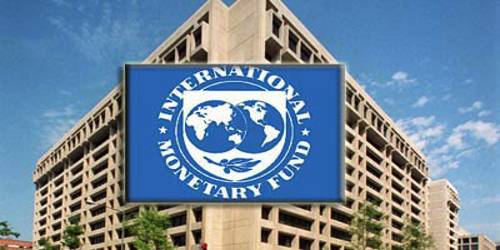By Tony Obiechina, Abuja
The International Monetary Fund (IMF) said on Tuesday that the rising debt levels among countries are currently limiting their ability to respond to new economic challenges.
This is just as the Fund sketched a bleak picture of what is in store for the global economy, estimating that growth will slow more than expected this year.
The IMF said the “anemic outlook” reflects the higher interest rates needed to bring down persistent inflation, the deterioration of financial conditions amid banking turmoil, the war in Ukraine and growing geo-economic fragmentation.
The IMF Director of Research Department, Pierre-Oliver Gourinchas said these while releasing the World Economic Outlook report.
Nigeria’s total public debt as at December 31, 2022, consisting of the domestic and external debt stocks of the Federal Government and the 36 State Governments and the Federal Capital Territory rose to N46.25trn or $103.11bn.
The total public debt to Gross Domestic Product ratio for December 31, 2022, was 23.20 per cent and indicates a slight increase from the figure for December 31, 2022, at 22.47 per cent.
The ratio of 23.20 per cent is still within the 40 per cent limit self-imposed by Nigeria, the 55 per cent limit recommended by the World Bank/international Monetary Fund, and, the 70 per cent limit recommended by the Economic Community of West African States.
The IMF Director said that the global economy would witness a decline in global growth rate from 3.4 percent in 2022 to 2.8 percent in 2023.
He said commodity prices that rose sharply following Russia’s invasion of Ukraine have moderated, but the war continues, and geo-political tensions are high.
According to the Fund, infectious COVID-19 strains caused widespread outbreaks last year, but economies that were hit hard such as China appear to be recovering, easing supply-chain disruptions.
He said, “Debt levels remain high, limiting the ability of fiscal policymakers to respond to new challenges. Commodity prices that rose sharply following Russia’s invasion of Ukraine have moderated, but the war continues, and geo-political tensions are high.
“Infectious COVID-19 strains caused widespread outbreaks last year, but economies that were hit hard—most notably China—appear to be recovering, easing supply-chain disruptions.
“Despite the fillips from lower food and energy prices and improved supply-chain functioning, risks are firmly to the downside with the increased uncertainty from the recent financial sector turmoil.
“The baseline forecast, which assumes that the recent financial sector stresses are contained, is for growth to fall from 3.4 percent in 2022 to 2.8 percent in 2023, before rising slowly and settling at 3.0 percent five years out––the lowest medium-term forecast in decades.
“Advanced economies are expected to see an especially pronounced growth slowdown, from 2.7 percent in 2022 to 1.3 percent in 2023. In a plausible alternative scenario with further financial sector stress, global growth declines to about 2.5 percent in 2023––the weakest growth since the global downturn of 2001, barring the initial COVID-19 crisis in 2020 and during the global financial crisis in 2009––with advanced economy growth falling below one percent.
“The anaemic outlook reflects the tight policy stances needed to bring down inflation, the fallout from the recent deterioration in financial conditions, the ongoing war in Ukraine, and growing geo-economic fragmentation.”
The IMF projected in the Report that global headline inflation will drop from 8.7 percent in 2022 to 7.0 percent in 2023 on the back of lower commodity prices, but underlying core inflation is likely to decline more slowly.
“Inflation’s return to target is unlikely before 2025 in most cases. Once inflation rates are back to targets, deeper structural drivers will likely reduce interest rates toward their pre-pandemic levels.
“Risks to the outlook are heavily skewed to the downside, with the chances of a hard landing having risen sharply,” it added.
The Report stated further that financial sector stress could amplify and contagion could take hold, weakening the real economy through a sharp deterioration in financing conditions and compelling central banks to reconsider their policy paths.
It added that pockets of sovereign debt distress could, in the context of higher borrowing costs and lower growth, spread and become more systemic.
In its recommendations in the Report, the IMF called for simultaneous, massive and synchronous tightening of monetary policy by most central banks, adding that this should start to bear fruit, with inflation moving back toward its targets.
The Report added, “More than ever, policymakers will need a steady hand and clear communication. The appropriate course of action is contingent on the state of the financial system. As long as the latter remains reasonably stable, as it is now, monetary policy should stay firmly focused on bringing inflation down.
“A silver lining is that the banking turmoil will help slow aggregate activity as banks curtail lending in the face of rising funding costs and of the need to act more prudently. In and of itself, this should partially mitigate the need for further monetary policy tightening.
“But any expectation that central banks will abandon the fight against inflation would have the opposite effect: lowering yields, supporting activity beyond what is warranted, and complicating the task of central banks.”
The IMF noted that tighter fiscal policy could also play an active role in stimulating economic growth.
By cooling off economic activity, it said such fiscal policies would support monetary policy, allowing real interest rates to return faster to their low natural level
“Appropriately designed fiscal consolidations will also help rebuild much needed fiscal buffers and help strengthen financial stability,” it added.


